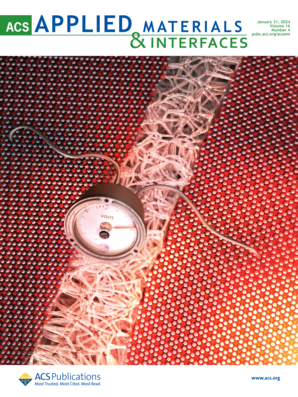Heterogeneous Condensation on Simplified Viral Envelope Protein Structures
IF 8.3
2区 材料科学
Q1 MATERIALS SCIENCE, MULTIDISCIPLINARY
引用次数: 0
Abstract
Elucidating the mechanisms of heterogeneous condensation on viral and bacterial envelopes is crucial for understanding biothreat transport phenomena and optimizing capture efficiency in condensation-based detection devices. We investigate the impact of viral envelope geometric parameters [e.g., surface structure pitch-to-diameter ratio (p/d)] due to protruding glycoproteins and surface wettability [via liquid–solid interaction intensity (f)] on heterogeneous condensation using molecular dynamics simulations. Complex glycoprotein structures were modeled as cylindrical pillars to analyze condensation rates and active surface areas across a range of p/d ratios (1.0, 1.2, 1.3, 1.7, 2.0, and ∞) and contact angles (θ = 15°, 75°, and 105°, corresponding to f = 3.0, 2.0, and 1.5) to address envelope geometries for a wide variety of viruses. The results indicate that initial condensation rates on surfaces with intermediate p/d ratios (e.g., 1.2–1.3) are significantly higher due to increased active surface area and droplet cluster formations. The rapid initial condensation fills up the gap between the pillars, reducing the active surface area and leading to a gradual decrease and a plateau in the condensation rate. The increased peak condensation rates are not observed as p/d increased to and above 1.7, as the exhibited behavior is like condensation on the unstructured surface. An increase in surface hydrophilicity (θ = 15°, f = 3.0) leads to faster nucleation and higher peak condensation rates compared to hydrophobic surfaces (θ = 105°, f = 1.5). The influence of viral envelope geometries and surface wettability on the heterogeneous condensation mechanisms offers foundational insights required to understand airborne biothreat transmission, which is particularly important in the atmosphere and respiratory tract, and improve biothreat detection methods utilizing condensation-based capture devices.

简化病毒包膜蛋白结构的非均相缩聚
阐明病毒和细菌包膜上的非均相冷凝机制对于理解生物威胁传输现象和优化冷凝检测设备的捕获效率至关重要。我们利用分子动力学模拟研究了病毒包膜几何参数[例如,由于突出的糖蛋白和表面润湿性[通过液固相互作用强度(f)]对非均相冷凝的影响[例如,表面结构直径比(p/d)]。将复杂的糖蛋白结构建模为圆柱柱,以分析p/d比(1.0、1.2、1.3、1.7、2.0和∞)和接触角(θ = 15°、75°和105°,对应于f = 3.0、2.0和1.5)范围内的冷凝速率和活性表面积,以解决各种病毒的包膜几何形状问题。结果表明,中间p/d比(如1.2-1.3)的表面上,由于活性表面积的增加和液滴团簇的形成,初始凝结速率明显更高。快速的初始凝结填补了柱间的空隙,减少了活动表面积,导致凝结速率逐渐降低并趋于平稳。当p/d大于或等于1.7时,没有观察到峰值凝结速率的增加,因为所表现的行为类似于非结构化表面上的凝结。与疏水表面(θ = 105°,f = 1.5)相比,表面亲水性(θ = 15°,f = 3.0)的增加导致更快的成核和更高的峰凝结速率。病毒包膜几何形状和表面润湿性对非均相冷凝机制的影响,为理解空气传播的生物威胁传播提供了基础见解,这在大气和呼吸道中尤为重要,并利用基于冷凝的捕获设备改进生物威胁检测方法。
本文章由计算机程序翻译,如有差异,请以英文原文为准。
求助全文
约1分钟内获得全文
求助全文
来源期刊

ACS Applied Materials & Interfaces
工程技术-材料科学:综合
CiteScore
16.00
自引率
6.30%
发文量
4978
审稿时长
1.8 months
期刊介绍:
ACS Applied Materials & Interfaces is a leading interdisciplinary journal that brings together chemists, engineers, physicists, and biologists to explore the development and utilization of newly-discovered materials and interfacial processes for specific applications. Our journal has experienced remarkable growth since its establishment in 2009, both in terms of the number of articles published and the impact of the research showcased. We are proud to foster a truly global community, with the majority of published articles originating from outside the United States, reflecting the rapid growth of applied research worldwide.
 求助内容:
求助内容: 应助结果提醒方式:
应助结果提醒方式:


